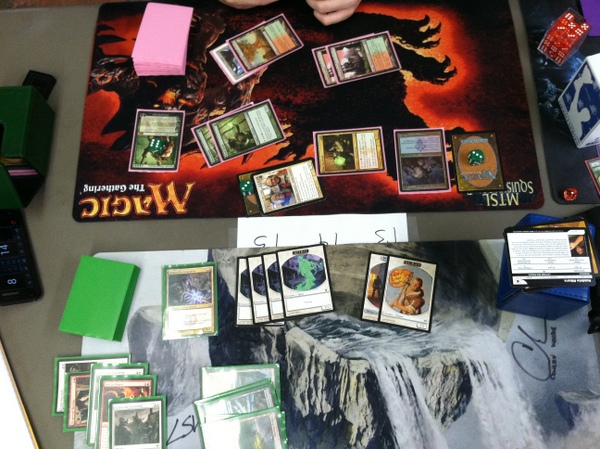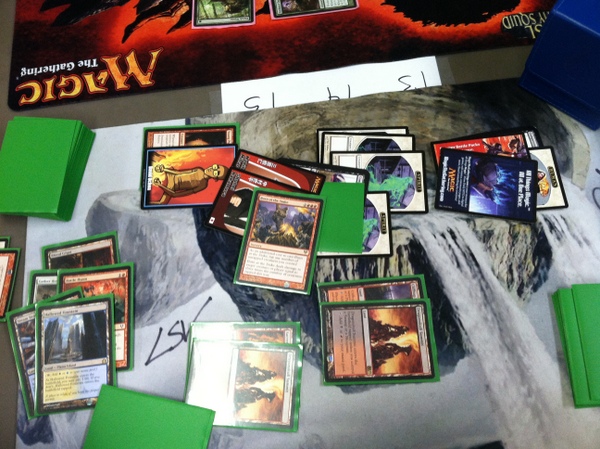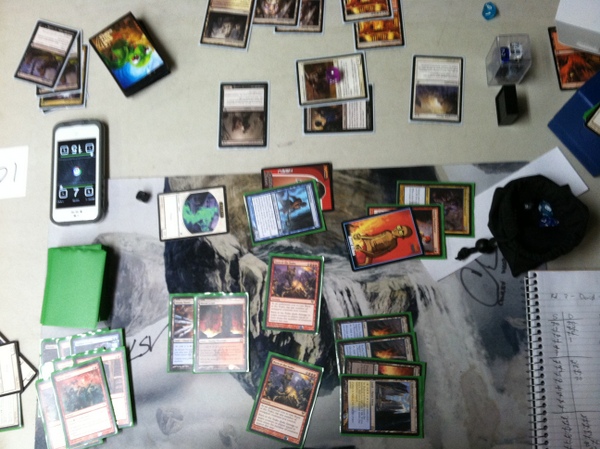Sideboarding is hard.
After more than a decade of playing Magic, the thing I struggle the most with is effective sideboarding. It seems like it shouldn’t be so difficult, especially if you understand the ways in which your deck interacts with an opponents. Yet it’s never this simple. What is your opponent taking out? Do they know what you’re bringing in? What cards should you specifically take out for X sideboard cards? Is it ever correct to sideboard in cards without taking anything out? I find myself constantly wracking my brain between games to answer these questions, though I worry I seldom make the optimal choices for games two and three.
Two weeks ago, I was playing a Modern tournament and my opponent, playing UWR Midrange, sided in two Celestial Purges against me. I was playing UWR control. My only target was one Ajani Vengeant. I don’t bring this up to shame my opponent, who seemed to make reasonable plays otherwise, but to point out how easy it is to sideboard incorrectly. He correctly identified that I didn’t have very many win conditions and saw a way to remove the card that destroyed all of his lands in the game prior. This reasoning isn’t necessarily incorrect, but the problem was that Celestial Purge doesn’t do anything against the other 59 cards in my deck.
The reason I bring up sideboarding here is because I sideboarded very poorly this past Wednesday while playing Burn at the Stake in my weekly Standard tournament. While I am more familiar with playing Burn at the Stake than I was when I wrote my last article, I was still unsure of when to weaken the combo and take out supplemental draw spells or ritual effects in favor of adding disruption to help protect my game plan. While I can honestly say I have a better understanding of the sideboarding process with this deck after punting a few games this week, I would need a few more weeks of piloting the deck to fully formulate sideboard plans against the major decks of the format. Since I don’t have that kind of time, perhaps you can read this article as a guide of how not to sideboard with Burn at the Stake.
For the record, here is the list I played at Wednesday Night Magic at Pandemonium Books & Games in Cambridge, Massachusetts:
Burn at the Stake
| Creatures (12) 4 Augur of Bolas 4 Goblin Electromancer 4 Young Pyromancer Spells (26) 4 Battle Hymn 3 Burn at the Stake 4 Desperate Ravings 4 Faithless Looting 2 Hidden Strings 4 Lingering Souls 3 Past in Flames 2 Reforge the Soul Land (22) 4 Blood Crypt 2 Clifftop Retreat 2 Dragonskull Summit 4 Hallowed Fountain 2 Sacred Foundry 4 Steam Vents 4 Sulfur Falls | Sideboard (15) 3 Boros Charm 4 Duress 3 Intangible Virtue 1 Moorland Haunt 1 Pithing Needle 2 Ral Zarek 1 Witchbane Orb |
Round 1—Kalin playing “Slumber Party” Jund (0-2)
Kalin was playing an innovative Jund list he brewed himself that seeks to exploit the evolve ability on Gyre Sage and the scavenge ability on Varolz, the Scar Striped, using some unconventional card choices. Kalin has both Vexing Devil and Slumbering Dragon in his deck as a means to quickly evolve Tarmosage and posthumously pile counters on Varolz. Throw in some Bioshifts for some combat blowouts or to place on Gyre Sage to power up a big Bonfire of the Damned, and you have Kalin’s deck. I actually saw Kalin play the deck last week and dismissed it as a janky—it has Slumbering Dragon in it after all—but after seeing it in action, I began to appreciate the power of its synergies. I’m a little upset I didn’t ask him for a deck list.
Game one, Kalin was able to disrupt me the turn before I would be able to fire off the combo by playing a Domri Rade and fighting my Goblin Electromancer. Over the next few turns I took a couple hits from a pair of Gyre Sages while building up my board, unfortunately for me he was able to cast a Bonfire of the Damned to wipe out my team. The game ended shortly after.
I sideboarded: nothing. Despite losing the first game, I felt that I was favored in the match-up. While Kalin’s deck was cool and synergistic, I thought I could just ignore his threats as Burn at the Stake seemed to have a faster clock than this midrange monstrosity. Furthermore, the only removal he had game one was Domri, which should only be able to fight once, and Bonfire of the Damned, which is certainly a card, but could miracle me out of the game whether I had Duress or not. The error in my reasoning was that I didn’t account for the cards that Kalin could bring in against me.
“The fatal flaw in every plan is the assumption that you know more than your enemy.” – Volrath (from the flavor text of Mana Leak)
Kalin brought in Golgari Charm, which is of course a common sideboard card in Jund, as well as an excellent way to kill tokens. In game two, I managed to cast Gather the Townsfolk with fateful hour, only to see my human tokens fall victim to the swiss army Golgari spell. If I had boarded in Duress here, there is a good chance I could strip his hand of removal before creating my legion of tokens.
Round 2—Brian with “Rumble in the Jungle” Gruul Midrange (2-1)
Even when Brian cast a turn three Garruk, Primal Hunter, I still felt like I could win this game. Even though the green planeswalker represented inevitability over the long game, I wasn’t planning on letting the game go that long. I had sculpted a nearly perfect hand, and with seven creatures in play I only had to untap to deal lethal damage with Burn at the Stake. Instead of just passing the turn and letting me Burn at the Stake for a million, Brian slammed a Ruric Thar and suddenly instead of winning the game, I was losing with no outs. Maybe someday I’ll be on the other side of a Ruric Thar, but until that day, I plan on losing every time he is resolved against me.
Brian even used the Hipsters of the Coast token I gave him to aid in my destruction:
I sideboarded: nothing. See a trend here?
Game two was a slobberknocker.
T2—Young Pyromancer
T3—Faithless Looting (two creatures) , Hidden Strings (three creatures), untap two lands, encode on Pyromancer, attack for two, copy Hidden Strings (four creatures) to untap Young Pyromancer and a land, play Battle Hymn (five creatures), cast Burn at the Stake for 15.
Game three, Brian kind of flooded out with only an Elvish Mystic and Predator Ooze pressuring me on the board. I was able to play an early Young Pyromancer and start playing token-making spells so that by the time I drew my Burn at the Stake, I had 14 creatures in play. I domed him for 42 damage, which is a new record for me. I even ran out of tokens and had to use extra sleeves:
Round 3—David Wu with Aristocrats (2-1)
While I don’t normally include last names, I started the round by talking to David about how if my last name was Wu, I think I would be obliged to build a Sun Quan, Lord of Wu EDH deck. David laughed a little bit—I think he was just being polite—before coughing a bunch in his arm. After his coughing subsided he said, “Sorry I’m coughing so much, I’m not sick, I just work in a genetics lab.” We laughed for a little bit before he said, “But I’m serious. I really do work in a genetics lab.”
Game one, David played a Cartel Aristocrat, next turn played Lingering Souls, and the following turn flashed bakc Lingering Souls and played a Blood Artist. Things looked dire for me, especially sitting at 12 life, but luckily I was able to combo off on my turn, chaining rituals and draw spells with Young Money Pyromancer out to Burn at the Stake for 24. This forced David to sacrifice all of his creatures, save the Cartel Aristocrat, which wasn’t enough to finish me off the following turn.
I sideboarded:
+4 Duress
-2 Reforge the Soul
-2 Hidden Strings
Game two, David spent his early turns killing my creatures while taking me out quickly with a Falkenrath Aristocrat. I mentioned to him after the game that I was still pretty close to going off, but was just short a Battle Hymn. David kind of smiled and said, “You weren’t going to go off, I still had a card in hand.” While shuffling up for game three, I wracked my brain for what card could kill off multiple creatures at instant speed. Electrickery?
I was able to quickly figure out the card that David was referring to when I played a turn two Duress, which revealed: Two Tragic Slip, Xathrid Necromancer, Godless Shrine, and Profit/Loss. I binned the Profit/Loss, which is pretty insane against me, and was able to play through the double Tragic Slip to Burn at the Stake for lethal.
The end of the game looked this this:
Round 4—Michael with UW Control (0-2)
When my opponents ask me what they should do when I take a picture of them, I usually just say, “Uh, give a thumbs up!” Michael decided he was going to do his best to just look super bummed out. Mission accomplished.
Game one, Michael played Syncopate on my first two threats—a Goblin Electromancer and a Young Pyromancer—then Dissipated my Lingering Souls. He played back to back end of turn Restoration Angels and I was quickly bashed out of the game with no action to speak of.
I sideboarded:
-2 Reforge the Soul
-2 Hidden Strings
-1 Past in Flames
-1 Burn at the Stake
+4 Duress
+2 Boros Charm
This was perhaps an even bigger blunder than not bringing in any cards against my first round opponent. Having had experience with Azorius Midrange, I should have realized that I couldn’t realistically plan to combo off against an opponent with seemingly infinite counters, especially post board where he could bring in both Negate and Dispel. I thought that maybe I could Duress away some counters and steal the game that way, but this is just not a realistic plan. While I think this is a bad match-up both pre-board and post-board, in retrospect the better plan would be to transform from a combo deck to a slightly more resilient midrange tokens deck. I should have boarded like this:
-4 Battle Hymn
-3 Past in Flames
-3 Burn at the Stake
-2 Reforge the Soul
-1 Hidden Strings
+4 Duress
+3 Intangible Virtue
+2 Ral Zarek
+3 Boros Charm
+1 Moorland Haunt
Game two was painful. Michael played an early Ratchet Bomb, held back my Young Pyromancer and a few elementals with Augur of Bolas, and always had counter magic for any relevant threat. I played all four Duresses that I brought in, but after casting a big Sphinx’s Revelation, Michael pretty much ensured that I was out of the game.
While it was disappointing to finish with a 2-2 record in my last week of playing Burn at the Stake, I’m more than willing to accept a few losses if it means that I learned something from it. This week, I was taught something I thought I had learned a long time ago: having a coherent sideboarding plan is vitally important in Magic. “Toss some stuff in, toss some stuff out” is not really a viable mantra for someone who seeks to be good at Magic. Knowing your sideboard plan is just as important as understanding your main deck.
Next week I will try two things I never thought I would: a juice cleanse and Bant Auras. I’ll report back on my findings.
At age 15, while standing in a record store with his high school bandmates, Shawn Massak made the uncool decision to spend the last of his money on a Seventh Edition starter deck (the one with foil Thorn Elemental). Since that fateful day 10 years ago, Shawn has decorated rooms of his apartment with MTG posters, cosplayed as Jace, the Mind Sculptor at PAX, and competes with LSV for the record of most lifetime Islands played. When he’s not playing Magic, Shawn works as a job coach for people with disabilities, plays guitar in an indie-pop band, and keeps a blog about pro wrestling.








